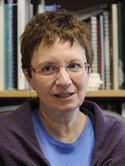Language Technologies and CALL: Difference between revisions
From HLT@INESC-ID
No edit summary |
(→Date) |
||
| Line 11: | Line 11: | ||
* 14:00, Thursday, June 25<sup>th</sup>, 2009 | * 14:00, Thursday, June 25<sup>th</sup>, 2009 | ||
* Room VA2, building of Civil Engineering | * Room VA2, building of Civil Engineering, IST-Alameda | ||
== Speaker == | == Speaker == | ||
Latest revision as of 17:59, 22 June 2009
| Maxine Eskenazi |
 She has been President and Chief Technical Officer of the Carnegie Speech™ Company (2001 - ). Carnegie Speech™ is a CMU spinoff. She is presently Associate Teaching Professor in the Language Technologies Institute of the School of Computer Science of Carnegie Mellon University. From 1980 to 1994 she worked as a grad student and then a tenured researcher at LIMSI-CNRS in Orsay, France. |
| Addresses: www mail |
Date
- 14:00, Thursday, June 25th, 2009
- Room VA2, building of Civil Engineering, IST-Alameda
Speaker
- Maxine Eskenazi, Carnegie Mellon University, USA
Abstract
Language Technologies are still in their early stages of use as far as Computer-assisted Language Learning (CALL) is concerned. But some notable progress has been made and some systems have appeared. This talk will discuss three applications that I have developed: NativeAccent, Let's Go Lexical Entrainment, and REAP. We will look at how each one uses language technologies. We will also discuss the challenges that each system overcomes when it combines the need to serve the language learner well with the present state of each technology. We will also examine the learning science questions that are raised when the interface between the technology and the student is created.